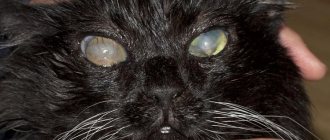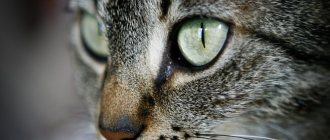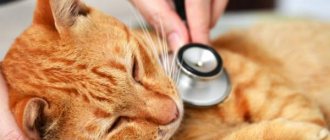Causes of a cloudy film on the eye
When a scar forms on the cornea of the visual organ, a cataract or leukoma appears, which manifests itself as a cloudy spot on one or both of the cat's eyes. This disease is very similar to cataracts, but only in the second case it is not the cornea that suffers, but the lens.
The fundamental cause of the disease is damage to the visual organ due to an ulcer, as well as all types of keratitis (bacterial, ulcerative, viral).
Other reasons include:
- Damages directly to the cornea - due to infectious diseases, mechanical damage, inflammatory process (with allergies and metabolic disorders);
- With swelling of the cornea or accumulation of calcium and cholesterol in it;
- With chlamydial trachoma - when the conjunctiva becomes thicker and a scar forms.
Experts distinguish two types of cataracts: congenital or acquired. According to statistical data, the majority of mustache sufferers suffer from a secondary form of the disease, which is a consequence of other diseases of the visual organ.
If a fluffy baby was born with a cataract, then most likely his mother suffered a viral or bacterial disease during pregnancy.
Depending on the location of the spot, the disease is divided into: central (when the central part of the visual organ is affected), peripheral (when the spot does not affect the pupil) and total (when the entire eye or even both are clouded).
Uevit
Uevitis is an inflammation of the choroid of the eye.
Cause. Uevitis in cats occurs as a result of eye injuries, metabolic disorders, eye tumors, autoimmune diseases, toxoplasmosis, rickettsiosis, diseases caused by viruses (feline leukemia, feline immunodeficiency, infectious peritonitis, etc.).
Clinic. Uevitis in a cat is accompanied by photophobia, lacrimation, eye pain, blepharospasm, strabismus, the cat's pupil is greatly reduced or takes on an uneven, blurry shape. The eyes have a red and cloudy appearance on clinical examination. There is a change in the color of the iris.
Treatment of ueviitis in a cat should be aimed at the cause that led to the disease. Eye drops are instilled into the eyes and painkillers are prescribed. Antibiotics and other antimicrobial drugs are used. If there is a threat of developing glaucoma, it is necessary to resort to surgical removal of the diseased eye.
Symptoms
Leukoma signals itself through visible changes in the visual organ and changes in the pet’s behavior:
- the fluffy hides away from the light and develops lacrimation;
- purulent discharge and nodules may appear;
- if the keratitis is vascular, the eye becomes cloudy and a reddish tint appears on the affected area;
- if the keratitis is purulent, then the cloudiness turns yellow;
- with an ulcerative lesion, the upper part of the cornea will be unevenly painted, and its surface will acquire a bumpy texture;
- if a fluffy has a problem due to intracranial pressure, then the thorn seems to stick out;
- if the pupil is injured, then in the process of scarring its contour changes;
It is very important to identify the disease at an early stage, immediately after damage or when there is visible redness. If the thorn degenerates into adipose tissue, then this causes complete atrophy of the visual organ. In addition, leukoma causes considerable discomfort to the pet, because its presence reduces visual acuity, especially if the film is located directly on the pupil.
Third eyelid prolapse
Prolapse of the third eyelid in a cat is often a secondary symptom of a number of infectious and parasitic eye diseases; it occurs when the optic nerve becomes inflamed.
Clinic. Cat owners and veterinary specialists use eyelids, which sometimes reach up to 1/3 of the entire visual area.
Treatment. Third eyelid prolapse in cats can be treated symptomatically or surgically. Treatment should be aimed at eliminating the primary disease that led to the loss of the third eyelid. Surgical treatment involves surgical excision of the prolapsed third eyelid.
Diagnostics
If your pet is diagnosed with leukoma, the most correct decision would be to take it to a veterinary clinic, where a specialist will first determine the root of the problem. The veterinarian will work according to the following scheme:
- Examine the fluffy's fundus. Using a slit lamp, he will analyze the structure of the conjunctiva, as well as the condition of the lens, cornea and iris;
- Conduct a fluorescein test - an effective method that excludes or confirms damage to the epithelial layer of the visual organ. If the cause of the problem is mechanical damage or ulceration, then this is the most effective stage of diagnosis;
- Perform a Seidel test, which is necessary to identify penetrating damage to the cornea or fistulas;
- Perform tonometry (to determine intraocular pressure) and gonioscopy (to examine the anterior part of the visual organ);
- If there is a suspicion of viral diseases (hepatitis, immunodeficiency virus or plague), the specialist will prescribe a referral for diagnostic tests;
- If there is a separation from the visual organ, he will take smears to analyze the flora;
- Perhaps he will give you a referral for an eye ultrasound.
Corneal ulcer
A corneal ulcer in a cat is accompanied by tissue destruction and poor healing. Superficial disintegration of the epithelium is called erosion.
Cause. The causes of the development of corneal ulcers can be both exogenous and endogenous. Exogenous causes include various traumatic injuries caused by the entry of hard and uneven foreign bodies into the conjunctival sac or as a result of direct injury to the cornea. Ulcers in cats occur when the eyelids or eyelashes roll up, when the cornea is constantly subjected to friction by the rolled-up edge of the eyelids or eyelashes. Chemical and thermal burns are always accompanied by an ulcerative process in a cat. Purulent conjunctivitis can cause the formation of corneal ulcers. Corneal ulcers can be observed when there is a violation of its innervation (neuroparalytic keratitis). Endogenous causes of ulcers in cats include a number of infectious diseases of cats, metabolic diseases, hypovitaminosis diseases, etc.
Clinical picture. Large ulcers are detected by a veterinary specialist at the clinic during examination - a defect, clouding of the cornea and discharged exudate are revealed. Small and superficial ulcers are determined by a veterinarian using side lighting and clouding of the cornea. Ulcerative processes in cats are in all cases accompanied by spasm of the eyelids, their swelling, mucopurulent, and more often purulent discharge, and the cat’s body temperature rises.
After the ulcers heal, scars form.
Treatment. Treatment of corneal ulcers is symptomatic or surgical. In the case when the eyeball is dissolved by a purulent process, it is removed. In veterinary clinics, sick animals are given antimicrobial therapy, including antibiotics, eye drops and ointments, and pain relief (novocaine blockades). Eye microsurgery is also performed to remove damaged areas of the cornea.
How to help your pet?
Effective therapy is prescribed by a doctor after identifying the causes of the disease. It is very important not to delay visiting the clinic while the disease is at the inflammatory stage and scar tissue has begun to form.
- If keratitis is detected, the fluffy must be treated with drops or ointments (tetracycline or fluxal). The course is at least 14 days.
- To speed up the process of corneal restoration, keratoprotectors are used, which are placed in the cat's eyes 3 times during the day. Course – 14 days.
- If a cat has a spot on its eye due to injury, then the visual organ should be immediately rinsed. solution or miramistin, and then use tetracycline drops.
- In case of severe pain, in order to alleviate the condition of the mustache, a specialist injects a solution of novocaine in combination with hydrocortisone under the eyeball.
- In case of increased pressure inside the visual organ, pilocarpine or brinzolamide will most likely be prescribed.
- The cataract itself is removed through surgery, but only after the inflammation has subsided.
For the therapy to fulfill its purpose, follow all the veterinarian’s instructions. Also, provide the mustache with rest and monitor the condition of the eyes (if it worsens, consult a doctor). If your furbaby is constantly rubbing his eyes, you should put a veterinary collar on him.
Blepharitis
Blepharitis is inflammation of the eyelids.
Cause. Traumatic damage to the eyelids, the presence of a bacterial or fungal infection, allergies in animals, diabetes (diabetes mellitus in animals, diabetes insipidus in animals), liver disease.
Clinical signs. During a clinical examination, a veterinarian notes redness of the eyelids, swelling, photophobia, profuse lacrimation, itching and burning in the area of inflammation of the eyelids, loss of hair and eyelashes around the eyelids.
Treatment of blepharitis should be aimed at eliminating the cause that led to blepharitis. The sore eye is washed with a decoction of calendula or chamomile, a solution of boric acid, potassium permanganate or furacillin. Eye drops are instilled into the conjunctival sac. If infection is present, antibiotics are used.
Preventive measures
It is easier to prevent any illness than to treat it later. Therefore, if the visual organ is injured, the mustache should be immediately taken to the hospital for examination.
At the same time, do not forget about scheduled vaccinations and regular preventive examinations of your pet.
Plan your cat's menu - it should include all the necessary macro and microelements, as well as vitamins. Protect your purr as much as possible from all kinds of chemicals and toxic substances.
If you suspect a disease of the visual organ, you should not use medications without first consulting a specialist. Also, do not use drugs intended for humans.
For the longevity and cheerfulness of a pet, its owner is obliged to closely monitor the health of his own pet. One possible problem could be a brown spot on your cat's eye. The appearance of such a pathology may indicate disturbances in the functioning of the cat’s organ of vision. So, if symptoms of the disease occur, it is recommended to contact a veterinarian in a specialized clinic to examine the animal, make an accurate diagnosis and prescribe the correct treatment.
Wounds and open injuries to the eye.
Cause. Most eye injuries and wounds in cats occur as a result of fights with their fellow cats, falling on sharp objects, or strong blows leading to damage to the skin.
Clinical signs. During a clinical examination, the veterinarian notes a violation of the skin in the area of the injured eye, the presence of scratches, wounds, and bleeding from the injured areas.
Treatment. The damaged area is washed with hydrogen peroxide, bleeding is stopped; in the presence of large wounds, pain relief and suturing are used, and antimicrobial therapy is administered locally. For complex and large eye injuries, eye microsurgery and sometimes removal of the damaged eye are performed.
Reasons for appearance
A cloudy spot on the iris of a cat occurs when the cornea of the eye is damaged. If a brown spot, black dots or a cataract appears in a cat’s eyes, this is evidence that the animal is losing visual acuity. The main reasons influencing the appearance of spots are considered to be the following pathological conditions:
- Corneal injury. It can occur with pathologies, inflammation, infections and injuries in the iris.
- Cloudiness of intraocular fluid. It appears when there is an accumulation of many leukocytes, proteins, and lipids.
- Diseases of the vitreous body.
- Cloudy lens. Develops during the formation of cataract disease.
Types of stains
Both a thorn and formations of different colors and pigment on the eyelid may appear on the cornea of the eye. They may not appear immediately, but after 2 years. Initially, the spot is small and unnoticeable, but over time it increases in size, bringing more and more discomfort to the cat. There are several varieties of such spots:
Black dots on the organ indicate cancer in the animal.
- Light. They occur when there are problems with the spine, if the animal has kidney, liver, or mental and nervous disorders.
- Brown spots. Appear on the iris or eyelids as a result of infectious diseases.
- Black dots. Formed during oncology.
- With a red tint. They appear when there are problems with the liver and enzymes in the blood.
- Growths of the “presentation” tobacco type. Develop with constipation and gastrointestinal problems.
If brown spots and formations appear on the cat's eyes, symptoms may appear, which are definitely recommended to be closely monitored. Visual acuity may decrease, the animal may not get into the bowl, it may skid when turning, and orientation in space may also be disturbed. The second aspect is considered to be increased irritability and nervousness of the pet. The cat begins to behave aggressively towards its owners and other pets in the house. Often a person notices the development of strabismus in a cat, the appearance of watery discharge from the eyeball. There is severe swelling of the cornea and redness on the iris and eyelids.
If such symptoms appear, it is recommended to immediately take your pet to an appointment with a veterinarian. When examining a cat, a specialist will prescribe appropriate treatment and tell you about methods for preventing the development of such diseases. Self-medication is prohibited.
Mycoplasmosis
Mycoplasma is a special type of microorganisms that occupy an intermediate position between bacteria and viruses.
In almost 90% of healthy cats this microorganism can be isolated, i.e. it is a normal inhabitant of the conjunctiva in cats. Mycoplasmosis in cats is an infectious disease that is characterized by the development of bilateral conjunctivitis with severe redness (hyperemia) of the entire conjunctiva, including the third eyelid.
Symptoms:
- Discharge from the eyes (tears, mucous or purulent discharge).
- Redness of the eyes.
- Sneezing, nasal discharge, and cough may occur.
— If both eyes of an animal are affected almost simultaneously, this indicates the infectious nature of the disease. If only one eye waters and turns red, then most likely it is conjunctivitis of non-contagious etiology. Often, mycoplasmosis in a cat disappears on its own after 7-10 days (if the underlying disease is eliminated and the immune system is strengthened). Otherwise, the disease becomes chronic.
- Joints are affected. At first the animal limps on one leg. Then it becomes noticeable that all the paws hurt. Mustache runs/jumps less. Getting up/ascending/descending becomes extremely difficult for the cat, so he sleeps almost all the time or lies down, meowing pitifully. The joints swell and do not bend.
- Body temperature rises.
Treatment
1. Treatment of the underlying infection using antibiotics and immunostimulants.
2. To treat conjunctivitis - eye drops with antibiotics.
============================================================================================================================================================================================
Diagnostic and treatment methods
When visiting a specialist, blood must be taken from the animal for testing.
When examining a furry patient, a veterinarian, namely an ophthalmologist, will make an accurate diagnosis and prescribe appropriate treatment. To confirm the diagnosis, the following procedures are prescribed:
- taking tests and examining them, especially blood and serology;
- measurement of intraocular pressure and comparison with healthy indicators;
- performing a cytology procedure;
- taking a smear from the eyeball and examining them;
- culture examination of the microflora of the eye and intraocular fluid.
A darkened iris in a kitten can only be cured with medication, after examining the test results by a professional doctor. Once the diagnosis becomes known, such diseases can be treated by carrying out procedures such as washing the eyeball with Metrogyl, or you can administer the drug Gamavit parenterally. It is also possible to lubricate the inflamed area with tetracycline ointment.
If, after testing, glaucoma is detected, then surgery may be necessary. Only the treating doctor should treat spots on an animal’s cornea, otherwise it can cause harm to the pet. It is not recommended to self-medicate, since the appearance of spots is considered a symptom of serious pathological changes in the cat’s body. Timely medical care will help protect your pet from discomfort, illness and dangerous consequences.
Diseases of the eyes and protective devices of the visual organs
Bruises and mechanical damage without compromising the integrity of the skin.
Cause. They occur in a cat as a result of a blow with a blunt object or as a result of mechanical damage (bumping into blunt objects, falling).
Clinical signs. During a clinical examination, the veterinarian notes the presence of bruises and hematomas in the eye area. In the area of injury, upon palpation, an increase in local temperature is noted, and a change in the size of the eyeball occurs.
Treatment. A cat with an eye injury should be taken to a veterinary clinic. To relieve pain in a sick animal, a 2% solution of novocaine, antimicrobial drops or eye ointment is instilled into the conjunctival sac. If there is a hematoma, it is necessary to apply cold to the hematoma (only on the eyelid area, not on the eyeball). If there are serious complications, it is sometimes necessary to resort to surgery.
It's better to keep an eye on pigment spots
Just as it is necessary to monitor the condition of moles on the skin - whether they are growing, whether their shape or color is changing - it is also necessary to monitor age spots in the eye. This comes with several possible complications.
Particularly dangerous is the transformation of pigment formation into a malignant oncological disease - melanoma. This is an extremely rare form of oncology (about 6 cases per million), but this makes it no less important to track the process in the early stages. Melanoma is one of the most dangerous forms of cancer: it is prone to rapid progression and metastasis. Therefore, the main thing is to carry out the necessary treatment in a timely manner and remove the affected tissue.
A nevus located on the inner surface of the eye can become overgrown with blood vessels and lead to retinal detachment (separation of the photosensitive layer from the underlying tissue). Detachment leads to partial loss of vision - sensory cells in this area of the retina are left without nutrition and die. Of course, this is also rare, but it is better to prevent it.
It is believed that the so-called freckles do not have the potential to transform into malignant formations. However, they are a reliable marker of excess insolation, which, in turn, can contribute to the development of eye diseases (cataracts, retinal degeneration).
Useful materials:
- The cat has cancer Stages of mammary gland cancer in cats Like in humans, cat mammary cancer has ...
- Cutaneous horn General description of the disease Cutaneous horn on the forehead or face (ICD 10 code - L57.0) -...
- Cat's eye Causes and signs of various types of eye diseases in cats Cats have many eye diseases. Necessary…
- Itching and odorless discharge Main causesBefore considering the factors that provoke the appearance of discharge that has a sour odor, it is necessary to immediately note...
Causes of keratitis in cats
Quite often, keratitis occurs as a condition that does not seriously affect the cat unless it is associated with a life-threatening viral disease. Genetics can also be a factor in the development of the disease, and it is often diagnosed in breeds such as Persian, Burmese, Himalayan and Siamese. The main causes of keratitis in cats include:
- feline herpes infection;
- direct eye injury;
- abnormal immune system response;
- ingrown eyelashes;
- dry eye syndrome;
- drooping eyelid syndrome;
- claucoma;
- uveitis (inflammation of blood vessels).
Cataract
Cataract is clouding of the lens. The disease often leads the cat to blindness. Cataracts in cats are associated with metabolic disorders in the lens and are accompanied by increased breakdown of protein components.
Cause. Trauma, infectious diseases, and chronic inflammatory eye diseases lead to cataracts in cats.
Clinic. At the last stage of the disease, the cat has difficulty seeing in the affected eye. Upon examination, the lens has a white or bluish color. The dilated pupil does not respond to light.
Treatment. The use of eye drops for cataracts can only slow down the degenerative processes developing in the lens.
Glaucoma
Glaucoma is an increase in intraocular pressure, which is accompanied by an enlargement of the eyeball in a cat.
Glaucoma in cats is usually not a primary disease, but often accompanies other eye diseases. If treatment is not started promptly, glaucoma causes vision loss in cats. Cats are usually asymptomatic. Glaucoma can be open-angle or closed-angle.
Clinic. Angle-closure glaucoma is characterized by redness of the eye, swelling of the eyelids, severe pain, clouding of the cornea, weakness, nausea, and vomiting.
Treatment. To normalize intraocular pressure, pilocarpine is used, to improve the outflow of excess fluid in the cat’s body, diuretics, retrobulbar administration of aminazine, and the prescription of painkillers. Sometimes it is necessary to resort to surgical intervention (extirpation of the eyeball).
Iritis (iridocyclitis)
Iritis (iridocyclitis) is inflammation of the iris and ciliary body.
Cause. Traumatic injury, inflammation spreading from the cornea, complications after eye surgery, infectious diseases.
Clinic. During a clinical examination, a clinic veterinarian notes a constriction of the pupil, dimming of the iris, photophobia, pain, and cloudy fluid in the anterior chamber of a sick cat. When conjunctivitis is associated with the disease, we note serous-purulent discharge.
Treatment. In order to restore pupil contraction, a 1% atropine solution, novocaine blockade, and antibiotics are prescribed. During treatment, eye drops and ointments with anti-inflammatory and antimicrobial effects have a good effect.











